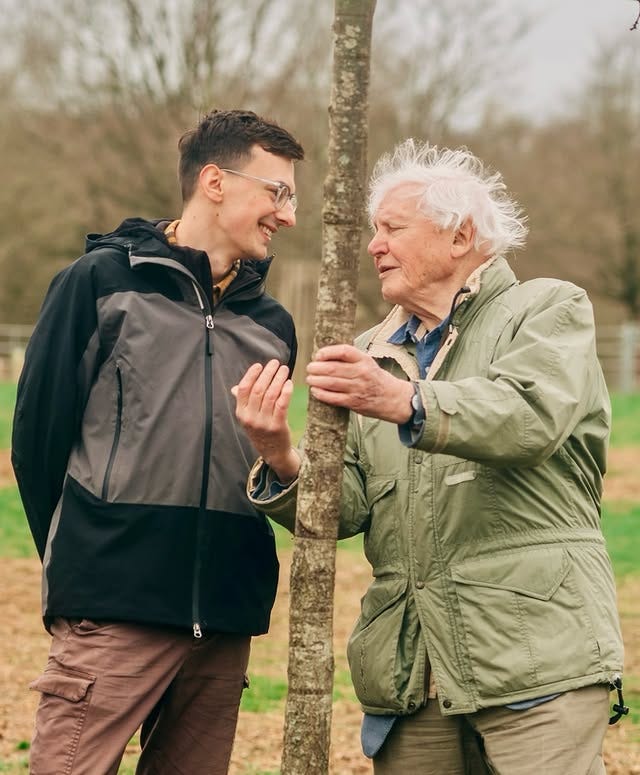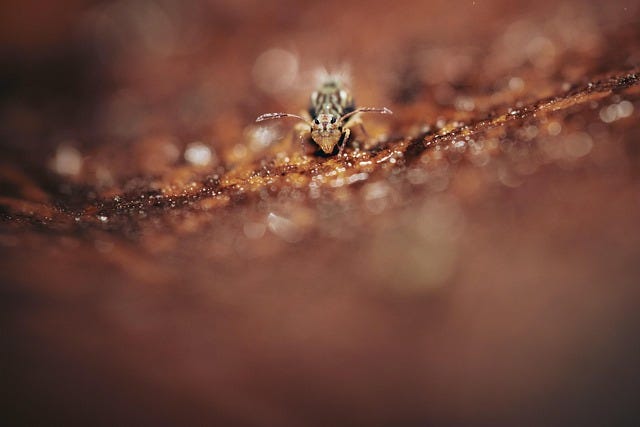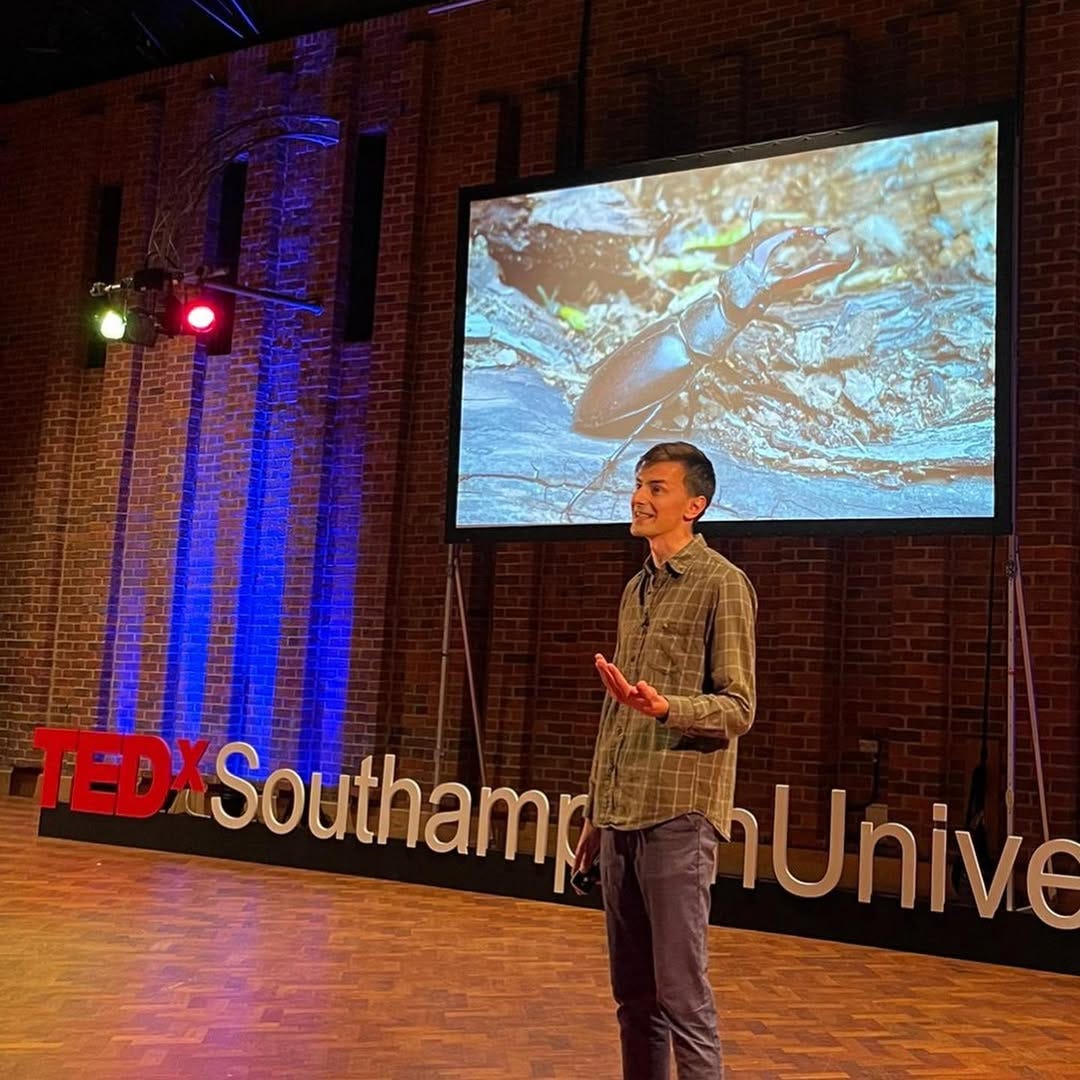"I spent many many days sifting through poo for incredible beetles"
Ecologist and nature guide Connor Butler lets the insects out of the bag!
Connor Butler is an ecologist and nature guide, known for his highly sought-after guided walks that allow attendees to nurture an awareness and appreciation of nature. He has a background as an ecologist and academic researcher, and has vast expertise in entomology - he has even given a riveting TED Talk on bugs!
Here, he tells us about what led him to develop a passion for ecology, what one might expect from one of his fantastic guided walks, and what is, in his opinion, the most underrated insect.
Follow Connor on Instagram @Connor_the_ecologist and visit his website at Connorbutler.co.uk
What was your path into ecology?
My parents were a huge influence on me becoming an ecologist. I grew up surrounded by the Oxfordshire countryside and we spent a lot of time outside. I have lots of memories of my dad taking me foraging to collect field mushrooms. We’d spend the morning walking across all the fields, dodging cattle and horses in search of fungi. When we got back home, my mum would cook up the mushrooms for lunch. I was also lucky enough to live close to two natural history museums, Oxford University’s Museum of Natural History and Natural History Museum Tring. Being free museums, my mum would often take me there for a day out and I was always fascinated by all the taxidermy. All this eventually led me to study Zoology at university, with a specialisation in ecology.
After graduating I moved to Singapore with some friends where I eventually got a job as an ecologist, conducting biodiversity surveys in beautiful patches of rainforest. After four years, I moved back to the UK and have been working in London for parks and gardens such as The Royal Parks and Chelsea Physic Garden on projects to connect people with nature. Insects are my main interest, so I’m often found squatting over logs or with a bug net in hand.
What can attendees learn on your guided nature walks?
The ethos that I try to instill in all my walks is that there is nature everywhere, and at scales that are often overlooked by the majority of us. If you have a magnifying lens, and some patience, you can go to the bleakest parks of the city and you will still find mosses, lichens and invertebrates. And if you can start to identify them, you will never be bored in life. It’s really the blessing of being an entomologist (people who study insects) or bryologist (those who study mosses and liverworts).
In addition to that, you are pretty much guaranteed to touch bugs.
You can find my upcoming walks here: connorbutler.co.uk/upcoming-events
What are the benefits of being outside in nature?
There are so many. I’m not a city person and I struggle living in a city as big as London - it’s not a place for a bug-loving, anxious introvert. Everytime I get stressed out by city life, I try to go for a walk in a green space. It also helps me detox from social media for a while. I think I’ve also probably made most of my big life decisions whilst out on a walk somewhere, I find it helps to put things into perspective. We’re all only here for a little bit, so be curious, spend time in beautiful places, and follow your passions.
And what are the wider benefits of a society more connected with nature?
We’re seeing an increase in GPs prescribing time in nature to people suffering with social anxiety and some mental health conditions. I’ve worked for several charities that offer these types of services and seen first hand the benefit of nature and gardening for people in recovery. The more that we value natural spaces for all their benefits, the better. Not only are they important for our mental health, but they are also important for water regulation, carbon sequestration and as habitat for wildlife.
You work with nature every day, but do you ever get time to just enjoy it for yourself, outside of the work context?
I feel so privileged every day that I get to spend out in nature, and especially more so when I’m paid to do so. Of course, I don’t get to spend every day outdoors. Every insect survey that I do probably means a couple of days staring down a microscope trying to identify them all. There are over 20,000 species of insect in the UK, and I need to narrow it down to the exact species. It’s very rewarding when I manage it, but it’s often after hours of frustration. I do sometimes get time to explore nature by myself, but not as much as I would like. There are many natural spaces in London I am yet to explore.
Where are the best places for the average Londoner to connect with nature?
West London’s Bushy Park is by far my favourite park in London, it’s an entomologist’s paradise. I spent a year there surveying the park’s dung beetles (my favourite insects). There is deer poo everywhere, which most would probably not consider an attractive feature, but for someone who loves dung beetles, it is incredible. I spent many many days sifting through poo for these incredible beetles. One of the most spectacular is the minotaur beetle, which specialises on rabbit dung, which it buries in tunnels beneath the surface.
What’s the most unique insect you’ve come across? And what makes it so unique?
I’ve recently become obsessed with woodlice and I talk about them on all my walks. Firstly, they have the most common names of any invertebrate in the UK. Depending on where you grew up, you may call them slaters, rolly pollies, pill bugs, chucky pigs, cheese bugs. What other creature has so many names, of which there are hundreds recorded.
In addition to that, they have a really interesting reproductive cycle, where it's often impossible to find male woodlice. This is partly due to a bacteria called Wolbachia, which is commonly found in woodlice. This bacteria can only be passed on through the eggs of female woodlice. If that egg hatches into a male woodlouse, the bacteria can’t be passed on. To get around this, the bacteria can change developing male woodlice to become functionally female and able to lay eggs. The bacteria has then given some females the ability to reproduce asexually, meaning that there is no use for male woodlice anymore.
And what about the most underrated insect?
I’ve recently been surveying springtails, of which I don’t recommend, they are incredibly difficult to identify. If you haven’t heard of springtails, you’re not alone, most people haven’t ever seen one. Springtails are microscopic six-legged invertebrates, closely related to insects. They were once grouped within insects, but are now a separate group. Springtails are often found in the soil or under logs, they are generally 1-5 mm long and some have a modified spring-like organ which allows them to jump to escape predators. Charles Darwin was supposedly unimpressed by them, calling them 'wingless, dull-coloured minute insects'. Now at first glance, you may have the same perception, but if you are able to look at them under the microscope, they have the most incredible colours, structures and body shapes imaginable - it’s all about scale.
In 2022, you gave a TEDx talk on bugs - how did you feel when you got the TEDx invite, and what was your experience like?
It was an unexpected honour—and a daunting one. I was invited by the University of Southampton, where I’d completed my undergraduate degree ten years earlier. It took me a long time to settle on a topic, but eventually, I chose to speak about the importance of connecting with insects and nature for humankind.
Writing the talk was one thing—rehearsing it was another. TED talks are meant to be around 14 minutes long and delivered without notes or a teleprompter. Your script has to be pre-approved and you’ve got to deliver it word for word - 14 minutes is a long time, it was probably 1800 words. It took me about two weeks of practice to nail down my talk without forgetting my lines.
When the day came, I was nervous. The venue was a large theatre with 500 people—far bigger than the groups of 30 or so I was used to speaking to. Unfortunately, there were technical issues, and a section of my talk wasn’t recorded properly. They managed to stitch together an edit, but some key lines were lost, not that you’d notice.
It was an incredible experience and really pushed me to become a better speaker, and now I’m less nervous when I talk in front of hundreds of people.
Tell me a nature fact that you’d have to see to believe!
Back to springtails - despite being incredibly overlooked and unknown, they exist in the soil at average densities of 40,000 springtails per cubic meter of soil. Every time you dig through your soil or compost, you are encountering many hundreds of springtails, you just don’t know it.
This interview is part of my ‘Rooting Around’ series, which features talks with innovative and pioneering voices in the world of horticulture and its adjacent fields. To read more interviews like this, click here.










